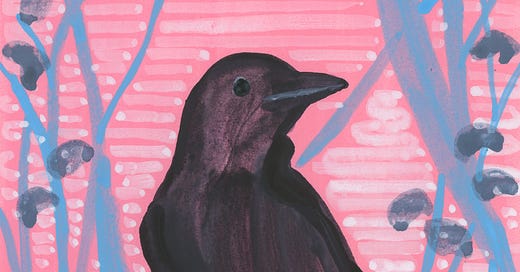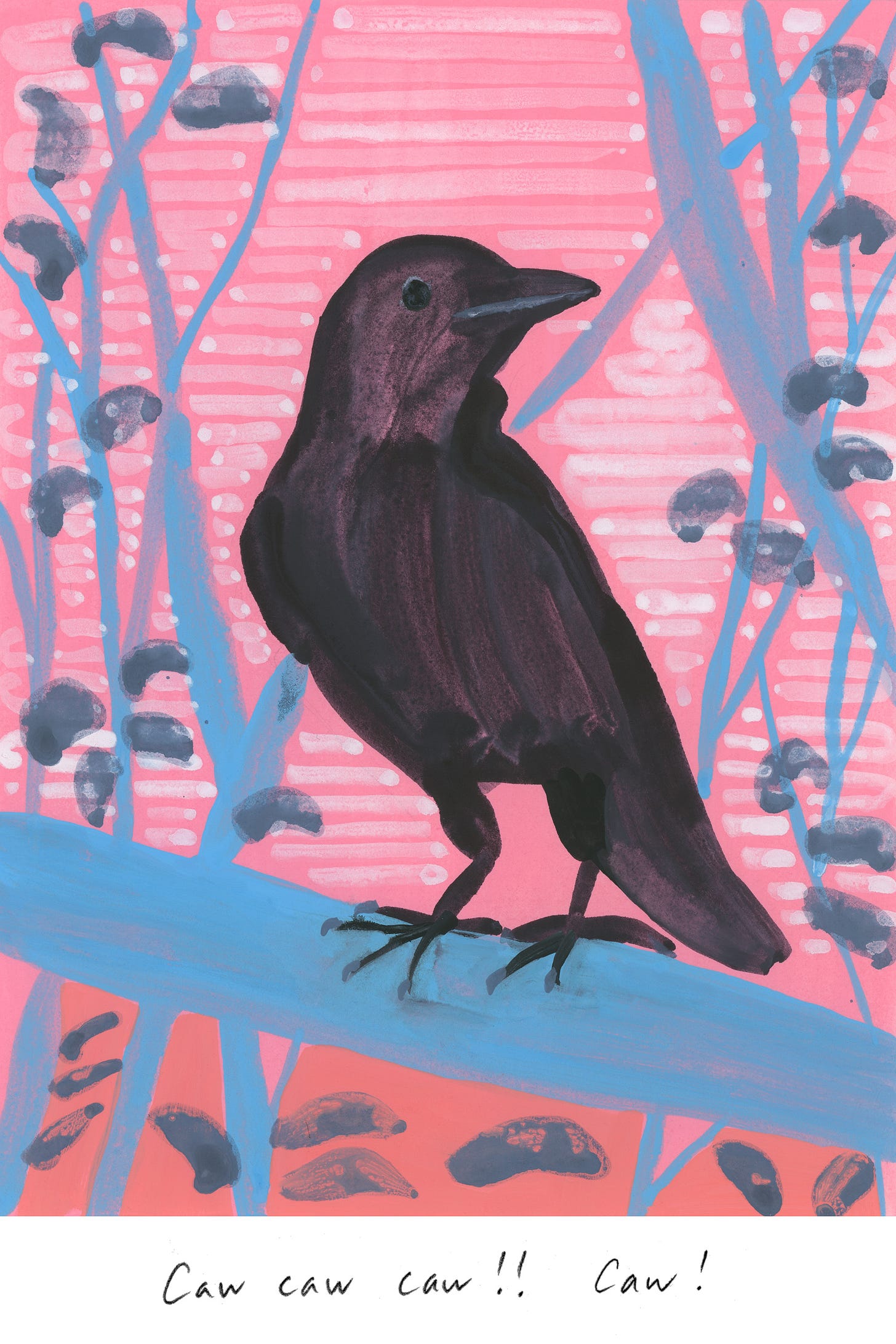Hi, friends — I’m looking to the skies this week as a respite from life on the ground. I hope you’re keeping well and would love to hear your stories about the clever and cinematic American crow (Corvus brachyrhynchos). — Amy Jean
I like seeing crows in winter, when their dark silhouettes look like punctuation to me—a comma in a tree, an apostrophe in a cloud. They are poetic that way.
They are also hilarious. A few will gather to infuriate our dog, Martina, a Jack Russell mix. They squawk from the trees on one side of the house until she runs to them and barks. Then, they flap over to the trees on the other side of the house and squawk again. They’ll pull her back and forth across the yard like that at least a few times (laughing all the way I’m sure).
Crows are smart birds, related to ravens (they are both corvids). Ravens have a close relationship with wolves in the wild, hunting and even “playing” with them. I wonder if the crows and our small dog have this same understanding, somewhere deep down. We tend to think that animals only communicate with their own species, if at all, but of course that isn’t true. Every sound resonates. The crows caw, the dog barks, the human calls: “Martina!”—what a fun game, really. Maybe the crows are trying to get to me. Studies have shown that crows are particularly good at recognizing and remembering human faces.
Crows are very social, adaptable, and caring creatures. They mate for life and family groups often stick together for years, helping to raise new offspring. Their vocalizations are distinctive, Caw! Caw!, and I enjoy hearing them, wondering what they’re up to as they pass by.
In winter, crows roost together at night in enormous numbers. The largest winter roost in Connecticut is in Hartford, with more than 10,000 birds. They stream in at dusk, some from nearby, some from further north, gathering in staging areas before settling together. There’s also a roost in the middle of Waterbury. They seem to be aligning their small cities with our small cities. No one knows exactly why or how they make their choices. If you see their numbers against a pale sky, they look like a typewriter in action, tapping out full words and sentences. I wonder what patterns they see in our movements below.
Many studies have explored the intelligence of crows. They are quite good at flexible thinking and approaching problems in creative ways. Apparently, they are as smart as a chimpanzee or small child (I like these comparisons even if they strike me as absurd). Aesop’s fable of the crow and the pitcher, written over 2,000 years ago, in which a crow fills a pitcher with stones in order to raise the water level, is close to the mark. The moral then: In a pinch, a good use of our wits may help us out.
We’ve been looking to the skies and taking inspiration from crows for a long, long time.
Crow links—
Follow a tangent through Aesop’s fables with this simple but lovely interactive version from the Library of Congress. Here is The Crow & the Pitcher.
You can see a real crow plopping stones into water in this experiment (it’s not just a fable!) [University of Auckland]
Watch 10,000 birds gather near Seattle, Washington, in this gentle video by the naturalist Kelly Brenner. You’ll see what I mean about the typewriter in the sky, though they also look like a musical score or computer code.
This crow solves a puzzle with sticks and stones that somehow reminds me of shrine challenges in The Legend of Zelda [BBC Earth]. I also like this one of a crow making a hook out of stick, which is the second video in this piece by National Geographic (if you have time, definitely watch the video in this same article of a cockatoo drumming and you will feel better about everything).
Crows hold “funerals” and gather around their dead. This is a creepy video, no getting around it, but it is fascinating [Deep Look/PBS Digital Studio].
“There’s a whole lot of whooping and hollering going on in these roosts. What are they doing in there?” Last year's Hartford roost was located near the Berry Rosenblatt U.S. Armed Forces Reserve Center on South Quaker Lane (I enjoy the specificity of this address) [Hartford Courant]
Here’s a short article about ravens, aka “wolf-birds,” and their relationship with wolves in Yellowstone. I would also recommend the book Mind of the Raven: Investigations and Adventures with Wolf-Birds by Bernd Heinrich.
Mice encounters—
Thank you for your stories of mice! Featuring a Rodent Officer, morning tea with a mouse, and the chocolate thieves of Brooklyn, in last week’s comments.
Also—
Next week I’m thinking about river otters, but I may change my mind. If you have suggestions please let me know.
My crow drawing is for sale; it’s a small friendly one. Please reply if you’re interested. I’m still meaning to make more owls and foxes, more to come.
Next Thursday the 21st I’ll be part of an online panel discussion on artist-poet collaborations, 6pm PST. Should be very fun and it’s free; please take a look at Hugo House for more information.
Thanks for reading. Caw! Caw Caw!





I could not love thus description more: “... they look like a typewriter in action, tapping out full words and sentences.”
I adore crows. Have you seen videos of them sledding in the snow?
I’m also here to quietly put in a vote for river otters!
Love crows and this picture is perfect. Think they’re beautiful even though many don’t seem to like them. Excited for river otters 🦦 (if you continue with them)